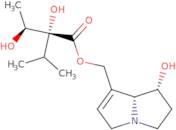
Product Information
- 2,3-Dihydroxy-2-(1-methylethyl)-butanoic acid (2,3,5,7a-tetrahydro-1-hydroxy-1H-pyrrolizin-7-yl) methyl ester
- Brn 4324630
- Butanoic acid, 2,3-dihydroxy-2-(1-methylethyl)-, (2,3,5,7a-tetrahydro-1-hydroxy-1H-pyrrolizin-7-yl)methyl ester, (1R-(1a,7(2R*,3S*),7a-beta))-
- Butanoic acid, 2,3-dihydroxy-2-(1-methylethyl)-, (2,3,5,7a-tetrahydro-1-hydroxy-1H-pyrrolizin-7-yl)methyl ester, [1R-[1α,7(2R*,3S*),7aβ]]-
- Butanoic acid, 2,3-dihydroxy-2-(1-methylethyl)-, [(1R,7aR)-2,3,5,7a-tetrahydro-1-hydroxy-1H-pyrrolizin-7-yl]methyl ester, (2R,3S)-
- Nsc 136052
- Retronecine, 7-[(2R,3S)-2,3-dihydroxy-2-isopropylbutyrate]
- [(1R,7aR)-1-hydroxy-2,3,5,7a-tetrahydro-1H-pyrrolizin-7-yl]methyl (2R,3S)-2,3-dihydroxy-2-(propan-2-yl)butanoate
- (+)-Indicine
- Indicine
- See more synonyms
Indicin is a biologically active compound that belongs to the group of pyrrolizidine alkaloids. It has a linear calibration curve and can be used for the determination of polymerase chain reaction (PCR) products in DNA samples. Indicin is a possible carcinogen, so it should not be consumed orally. Indicin has been shown to have toxicological effects on rats and mice when it was given intravenously or intraperitoneally, but not when administered orally. Indicin also has potential as an anti-inflammatory agent, which may be due to its ability to bind toll-like receptor 4 (TLR4).
Chemical properties
Technical inquiry about: 3D-FI161707 Indicin
If you want to request a quotation or place an order, please instead add the desired products to your cart and then request a quotation or order from the cart. It is faster, cheaper, and you will be able to benefit from the available discounts and other advantages.





